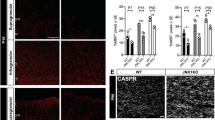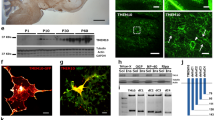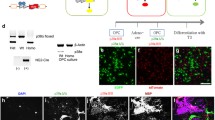Abstract
Myelination in the central nervous system takes place predominantly during the postnatal development of humans and rodents by myelinating oligodendrocytes (OLs), which are differentiated from oligodendrocyte progenitor cells (OPCs). We recently reported that Sox2 is essential for developmental myelination in the murine brain and spinal cord. It is still controversial regarding the role of Sox2 in oligodendroglial lineage progression in the postnatal murine spinal cord. Analyses of a series of cell- and stage-specific Sox2 mutants reveal that Sox2 plays a biphasic role in regulating oligodendroglial lineage progression in the postnatal murine spinal cord. Sox2 controls the number of OPCs for subsequent differentiation through regulating their proliferation. In addition, Sox2 regulates the timing of OL differentiation and modulates the rate of oligodendrogenesis. Our experimental data prove that Sox2 is an intrinsic positive timer of oligodendroglial lineage progression and suggest that interventions affecting oligodendroglial Sox2 expression may be therapeutic for overcoming OPC differentiation arrest in dysmyelinating and demyelinating disorders.










Similar content being viewed by others
References
Franklin RJ, Gallo V (2014) The translational biology of remyelination: past, present, and future. Glia 62:1905–1915
Graham V, Khudyakov J, Ellis P, Pevny L (2003) SOX2 functions to maintain neural progenitor identity. Neuron 39(5):749–765
Lee KE, Seo J, Shin J, Ji EH, Roh J, Kim JY, Sun W, Muhr J et al (2014) Positive feedback loop between Sox2 and Sox6 inhibits neuronal differentiation in the developing central nervous system. Proc Natl Acad Sci U S A 111(7):2794–2799
Kondo T, Raff M (2004) Chromatin remodeling and histone modification in the conversion of oligodendrocyte precursors to neural stem cells. Genes Dev 18(23):2963–2972
Lyssiotis CA, Walker J, Wu C, Kondo T, Schultz PG, Wu X (2007) Inhibition of histone deacetylase activity induces developmental plasticity in oligodendrocyte precursor cells. Proc Natl Acad Sci U S A 104(38):14982–14987
Niu W, Zang T, Zou Y, Fang S, Smith DK, Bachoo R, Zhang CL (2013) In vivo reprogramming of astrocytes to neuroblasts in the adult brain. Nat Cell Biol 15(10):1164–1175
Su Z et al (2014) In vivo conversion of astrocytes to neurons in the injured adult spinal cord. Nat Commun 5:3338
Heinrich C, Bergami M, Gascón S, Lepier A, Viganò F, Dimou L, Sutor B, Berninger B et al (2014) Sox2-mediated conversion of NG2 glia into induced neurons in the injured adult cerebral cortex. Stem Cell Reports 3(6):1000–1014
Hoffmann SA, Hos D, Kuspert M, Lang RA, Lovell-Badge R, Wegner M, Reiprich S (2014) Stem cell factor Sox2 and its close relative Sox3 have differentiation functions in oligodendrocytes. Development 141(1):39–50
Zhao C, Ma D, Zawadzka M, Fancy SPJ, Elis-Williams L, Bouvier G, Stockley JH, de Castro GM et al (2015) Sox2 sustains recruitment of oligodendrocyte progenitor cells following CNS demyelination and primes them for differentiation during remyelination. J Neurosci 35(33):11482–11499
Zhang S, Zhu X, Gui X, Croteau C, Song L, Xu J, Wang A, Bannerman P et al (2018) Sox2 is essential for oligodendroglial proliferation and differentiation during postnatal brain myelination and CNS remyelination. J Neurosci 38:1802–1820
Stolt CC, Rehberg S, Ader M, Lommes P, Riethmacher D, Schachner M, Bartsch U, Wegner M (2002) Terminal differentiation of myelin-forming oligodendrocytes depends on the transcription factor Sox10. Genes Dev 16(2):165–170
Hammond E, Lang J, Maeda Y, Pleasure D, Angus-Hill M, Xu J, Horiuchi M, Deng W et al (2015) The Wnt effector transcription factor 7-like 2 positively regulates oligodendrocyte differentiation in a manner independent of Wnt/beta-catenin signaling. J Neurosci 35(12):5007–5022
Lang J, Maeda Y, Bannerman P, Xu J, Horiuchi M, Pleasure D, Guo F (2013) Adenomatous polyposis coli regulates oligodendroglial development. J Neurosci: Off J Soc Neurosci 33(7):3113–3130
Zhao C, Deng Y, Liu L, Yu K, Zhang L, Wang H, He X, Wang J et al (2016) Dual regulatory switch through interactions of Tcf7l2/Tcf4 with stage-specific partners propels oligodendroglial maturation. Nat Commun 7:10883
Dugas JC, Cuellar TL, Scholze A, Ason B, Ibrahim A, Emery B, Zamanian JL, Foo LC et al (2010) Dicer1 and miR-219 are required for normal oligodendrocyte differentiation and myelination. Neuron 65(5):597–611
Moyon S, Huynh JL, Dutta D, Zhang F, Ma D, Yoo S, Lawrence R, Wegner M et al (2016) Functional characterization of DNA methylation in the oligodendrocyte lineage. Cell Rep 15:748–760
Moyon S, Casaccia P (2017) DNA methylation in oligodendroglial cells during developmental myelination and in disease. Neurogenesis (Austin) 4(1):e1270381
Ishii A, Fyffe-Maricich SL, Furusho M, Miller RH, Bansal R (2012) ERK1/ERK2 MAPK signaling is required to increase myelin thickness independent of oligodendrocyte differentiation and initiation of myelination. J Neurosci 32(26):8855–8864
Ishii A, Furusho M, Bansal R (2013) Sustained activation of ERK1/2 MAPK in oligodendrocytes and Schwann cells enhances myelin growth and stimulates oligodendrocyte progenitor expansion. J Neurosci 33(1):175–186
Marques S, Zeisel A, Codeluppi S, van Bruggen D, Mendanha Falcao A, Xiao L, Li H, Haring M et al (2016) Oligodendrocyte heterogeneity in the mouse juvenile and adult central nervous system. Science 352(6291):1326–1329
Dai J, Bercury KK, Ahrendsen JT, Macklin WB (2015) Olig1 function is required for oligodendrocyte differentiation in the mouse brain. J Neurosci 35(10):4386–4402
Shen S, Sandoval J, Swiss VA, Li J, Dupree J, Franklin RJM, Casaccia-Bonnefil P (2008) Age-dependent epigenetic control of differentiation inhibitors is critical for remyelination efficiency. Nat Neurosci 11(9):1024–1034
Fernandez-Castaneda A, Gaultier A (2016) Adult oligodendrocyte progenitor cells—multifaceted regulators of the CNS in health and disease. Brain Behav Immun 57:1–7
Young KM, Psachoulia K, Tripathi RB, Dunn SJ, Cossell L, Attwell D, Tohyama K, Richardson WD (2013) Oligodendrocyte dynamics in the healthy adult CNS: evidence for myelin remodeling. Neuron 77(5):873–885
Xiao L, Ohayon D, McKenzie IA, Sinclair-Wilson A, Wright JL, Fudge AD, Emery B, Li H et al (2016) Rapid production of new oligodendrocytes is required in the earliest stages of motor-skill learning. Nat Neurosci 19(9):1210–1217
Tripathi RB, Jackiewicz M, McKenzie IA, Kougioumtzidou E, Grist M, Richardson WD (2017) Remarkable stability of myelinating oligodendrocytes in mice. Cell Rep 21(2):316–323
Reiprich S, Wegner M (2014) From CNS stem cells to neurons and glia: Sox for everyone. Cell Tissue Res
Reiprich S, Wegner M (2014) Sox2: a multitasking networker. Neurogenesis (Austin) 1(1):e962391
Liu YR, Laghari ZA, Novoa CA, Hughes J, Webster JRM, Goodwin PE, Wheatley SP, Scotting PJ (2014) Sox2 acts as a transcriptional repressor in neural stem cells. BMC Neurosci 15:95
Engelen E, Akinci U, Bryne JC, Hou J, Gontan C, Moen M, Szumska D, Kockx C et al (2011) Sox2 cooperates with Chd7 to regulate genes that are mutated in human syndromes. Nat Genet 43(6):607–611
Jung M, Krämer E, Grzenkowski M, Tang K, Blakemore W, Aguzzi A, Khazaie K, Chlichlia K et al (1995) Lines of murine oligodendroglial precursor cells immortalized by an activated neu tyrosine kinase show distinct degrees of interaction with axons in vitro and in vivo. Eur J Neurosci 7(6):1245–1265
He Y, Dupree J, Wang J, Sandoval J, Li J, Liu H, Shi Y, Nave KA et al (2007) The transcription factor Yin Yang 1 is essential for oligodendrocyte progenitor differentiation. Neuron 55(2):217–230
Ye F, Chen Y, Hoang TN, Montgomery RL, Zhao XH, Bu H, Hu T, Taketo MM et al (2009) HDAC1 and HDAC2 regulate oligodendrocyte differentiation by disrupting the beta-catenin-TCF interaction. Nat Neurosci 12(7):829–838
Lu QR, Sun T, Zhu Z, Ma N, Garcia M, Stiles CD, Rowitch DH (2002) Common developmental requirement for Olig function indicates a motor neuron/oligodendrocyte connection. Cell 109(1):75–86
Chen C et al (2017) Astrocyte-specific deletion of Sox2 promotes functional recovery after traumatic brain injury. Cereb Cortex:1–16
Wheeler NA, Fuss B (2016) Extracellular cues influencing oligodendrocyte differentiation and (re)myelination. Exp Neurol 283(Pt B):512–530
Acknowledgements
Grant support was from Shriners Hospitals for Children (F.G., S.Z.), 2016YFC0503200 (X. Z.), and NIH (R01NS094559, R21NS093559 to F.G.).
Author information
Authors and Affiliations
Corresponding author
Rights and permissions
About this article
Cite this article
Zhang, S., Rasai, A., Wang, Y. et al. The Stem Cell Factor Sox2 Is a Positive Timer of Oligodendrocyte Development in the Postnatal Murine Spinal Cord. Mol Neurobiol 55, 9001–9015 (2018). https://doi.org/10.1007/s12035-018-1035-7
Received:
Accepted:
Published:
Issue Date:
DOI: https://doi.org/10.1007/s12035-018-1035-7




